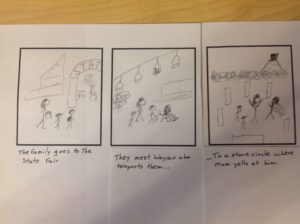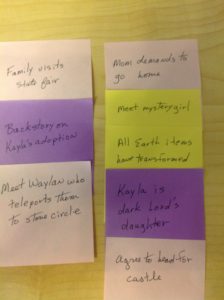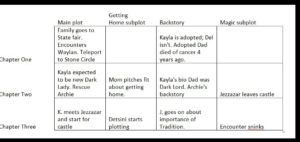Storyboarding is a structure analysis technique that comes out of the film industry, where it’s been used since the very early days to give writers, directors, and producers a sort of visual outline of a film. A true storyboard is a series of drawings, each of which encapsulates a scene or plot point, and each of which is captioned with a line or two of dialog or a very brief summary of the action in a scene. This makes it really helpful for people working on anything that involves visual media: film, theater, comics, graphic novels, videos, animated computer games, and so on.
Some years back, the technique started being adopted by novelists. In the process, the original idea has been altered and adapted in a lot of different ways to suit the needs of various writers. Not every writer uses them. Below are some examples: take what you think looks helpful or fun, and ignore the rest.
Below is a classic storyboard of the first few scenes of my current WIP. It has my bad line drawings (that think that looks like a volcano in the background of the third picture is supposed to be a tower on top of a mountain) combined with a really short scene-summary; you get the idea of how it might look if I laid out the whole story this way. If I were doing it for real, I’d make up cards with one picture-plus-caption per card, which would allow me to shift scenes and events around easily. (That is, in fact, how I’m told it’s done in film studios.)
Next is the equally classic Post-It-Note version, which eliminates the pictures but is far easier and faster to set up (especially if you can’t draw well) and is really easy to rearrange. If you don’t have cats, index cards work fine; if you have cats, I recommend sticky notes of some kind, because the cats can’t jump on the table and scatter them all over just when you’ve arrived at the perfect arrangement.
In the above set-up, I’ve laid out the Post-Its for the first two chapters, by chapter, and I’ve color-coded things – pink for the main story line, dark purple for important backstory, yellow for a particular subplot. If I continued, I’d use blue for a different subplot and green for yet another, but those don’t come in for a while yet. This allows me to see at a glance that I have a lot more important stuff in Chapter Two than in Chapter One, and that there are two subplot-relevant things happening back to back in Chapter Two. The back-to-back things in Chapter Two aren’t a huge problem this early in the story, but I would probably want to see if I can get more stuff to happen in Chapter One, or else eliminate it entirely and start with Chapter Two.
I use this method a lot, usually around mid-book or during revisions, because I often get really caught up in following a particular subplot and end up with five or six dark green subplot Post-It scenes in a row…and nothing at all happening in the main storyline or character development. Color-coding the Post-Its makes this really obvious, and I can rearrange them (and keep track of them) a lot more easily than if I tried to fix the problem by cutting and pasting. I usually use gray for important off-stage events, because sometimes it matters that they come before or after particular on-stage events, and that helps me keep track, so I don’t end up with a character attending the on-stage ball just after he/she supposedly got kidnapped down in the village offstage.
A variation on the Post-It method is to lay the Post-Its out according to tension, or acts, or rising and falling action, rather than splitting them up by chapter. You can also include events that happen offstage, so that you can see when/where they happen relative to when they impact the main storyline.
Many of the programs that include storyboarding focus mainly on following viewpoint characters and/or locations. I usually write single-viewpoint novels, so these aren’t much help to me, but if I were doing this as multiple-viewpoint, it might look something like this:
This chart, which I set up in Excel, shows the scenes in the hypothetical order in which they’d occur in the manuscript, but separated by viewpoint character, so you can follow each character’s storyline and see if it makes sense, both in terms of what happens in it and in terms of what else is happening. In this example, two things are instantly obvious: first, I have two Waylan-viewpoint scenes back-to-back, which makes him seem like the main character, and second, the scene with him hunting for Kayla happens before she even arrives at the fair. The fix is equally obvious: swap the order of the Waylan viewpoint scene and the first Kayla viewpoint scene, or maybe even put the second Waylan scene right after the second Archie scene.
(My actual story uses only the Kayla-viewpoint scenes; the other events occur, but since she’s not there, neither she nor the reader knows about them until much later.)
Charts can also be used to track subplots, complications, and offstage events, by chronology, by location, by scene/chapter, or by anything else you want to look at:
On this chart (also done as an Excel spreadsheet), the first item under “magic subplot” and the last one under “getting home” both take place offstage, but they’re important to their particular columns. I’d probably want to color-code them somehow if I were to continue laying this out for the whole story.
A final caveat: While storyboarding can be a really helpful analysis tool, it can also turn into a cat-vacuuming time sink. If it’s helping and making the story better, do it; if it becomes a way of avoiding your daily writing stint, put it aside.
Now excuse me; I have to go write.







I’ve never tried drawing it out. My sketches would probably look pretty awful. But I love the sticky note idea, it’s very similar to what I do in Scrivener.
By coicidence, I’m at a point in my WIP where I probably should storyboard a scene or two on a finer, sub-scene level. Or maybe the right word is “choreograph.” With a map-like overhead view.
All because I picked the wrong bad guy to be the second to the mook who challenged my protagonist to a duel, a few chapters back. Now I have to go back and pick a different bad guy, which means working out a different set of complications and possible outcomes, since my protagonist will now want to fight the bad-guy second in preference to fighting the mook.
My current WIP is a slice-of-life with a VERY large cast of characters. Even deliberately going back and re-writing as many bits as possible from the lead POV’s I’ve still got an abundance of viewpoints. Looks like the colored post-it method might help.
Any thoughts on how to manage a proliferation of sub-plots and POV’s?
Lots. So I’m going to handle this as a post, or possible a series of posts, if you don’t mind.
Well, you might attempt reading _The Dream of the Red Chamber,_ a classic Chinese novel with about forty major characters and several hundred minor ones. You’ll either go mad in white linen, or learn something. (N.B. I have not done this myself.)
I did a sort-of storyboard for the last chapter of the last novel I finished, with stick-figure sketches of several scenes. I don’t know why it was necessary, since I already knew what happened and I didn’t change the order or anything, but sketching it out made it possible for me to write the scenes in a way that I hadn’t otherwise been.
On a wild tangent, I’ve never understood why “cat-vacuuming” has become a term for useless activity. It seems to me that vacuuming the cats would be very useful — get all that cat hair before it gets spread all over the house. If only the cats could be persuaded to hold still for it….
Cat-vacuuming is a shortcut from a comment/excuse somebody made years back, along the lines of “I don’t have time to write today; I have to vacuum the cat.” Which, in turn, was supposedly inspired by someone claiming they couldn’t write because they’d left Fluffy in the microwave. (I think in that case Fluffy was a turtle, but I could be wrong…) It’s not so much that cat-vacuuming is useless activity as that it’s activity that’s probably unnecessary but that’s being used to justify not-writing.
Ah, fandom perpetuating a random remark into internal jargon. That makes sense. Thank you.
(And now I want to write the Adventures of Fluffy the Turtle….)
For folks who want to storyboard (or maybe make your own comic book/graphic novel), Comic Book Paper is a great resource for page-layout templates. They’re free for private or commercial use, and, as they say, free is a very good price.
Hmm. The link to Comic Book Paper disappeared. Here it is again (with the HTTP bits taken out so it shows up, I hope): comicbookpaper.com